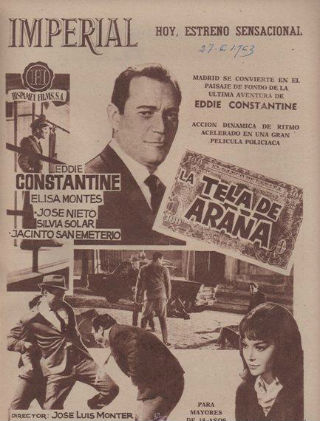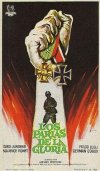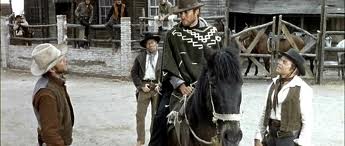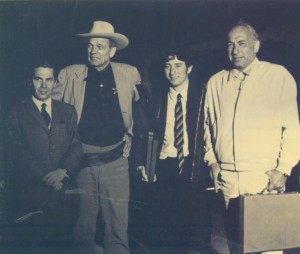Then on November 1960, I received
Niels Larsen's famous letter and quickly packed my few belongings
and returned to Madrid. I had agreed to meet with my ex-boss at the
Ballesteros Studios, located on García de Paredes Street. When I
stepped inside I realized that I had discovered a world wherein I
wanted to spend the rest of my life. That was my first contact with
film production and it has never crossed my mind to do anything
else.
That day they were filming: they
were doing light and makeup tests on two actresses: Silvia Solar, a
gorgeous blonde, and Elisa Montes, famous for being married to
Antonio Ozores and being the sister of Emma Penella and Terele
Pávez. The screen tests were being directed by Niels Larsen and the
photographer was Michel Kelber. The leading character of the film
was Eddie Constantine, a famous French star born in the USA and
very popular for having been the protagonist in a series of feature
films about a tough detective. I remember that I became good
friends with his makeup artist, a lady who was intrigued by the
fact that I had brought my Finnish girlfriend from England with me.
She was Tarja and we later got married. The make-up artist kept
asking me, curious and a little jealous, if the previous night:
avez-vous fait de lésquí?
The script of "Tela de araña"
(Spider Web) was written by Niels Larsen with the help of Gudie
Lawaetz. On the set there were three directors: Larsen, José Luis
Monter, representing the Sindicato Nacional del Espectáculo
(National Trade Union of Shows), and Guy Lefranc, a director sent
over by the film's French co-producer. That sort of arrangement was
very common in those days and people were more or less prepared to
work under such conditions.
During the shooting of that film I
got on very well with Augusto Boué, the production manager. I
became his favorite assistant; his confidence in me was decisive
for my future since he opened doors to the world of professional
cinema, which are so difficult to enter. Our relationship, apart
from being a close friendship, was very special; Augusto was more
like a father to me than a boss.

At the end of the shoot, which was
problematic due to a lack of funds and confrontations between
directors, producers and cast, I gained two positive experiences.
On the one hand, I thought I had learnt everything about cinema
there was to learn. And on the other, I met Michel Kelber and
Julián Buraya. The latter was the first assistant of Boué and there
were four things about him that were hardly compatible with each
other: he was a Phalangist, a heavy drinker, an ex-fighter from the
Blue Division and a homosexual. Later on, he worked as production
manager in some of the movies I made.
When the filming was over, Boué
recommended me to the production manager Eduardo García Morato, who
was working on an independent American film project. It was
envisaged that the entire movie was going to be shot in Spain.
Directed by George Sherman, it was called "Más cornadas da el
hambre" (Wounds of Hunger). The producer was Saul Swimmer and the
co-producers were Stan Torchia, Mark Damon and Brud Talbot. The
latter two were also going to star in the movie with Tony Anthony
and Luciana Paluzzi. "Más cornadas da el hambre" wasn't fully
finished due to lack of money, even though Talbot was the fiancée
of the daughter of American millionaire Dupont, who was financing
the movie. During the shooting, several production crews were
either fired or quit and I ended up being the right-hand-man of
these young producers. Most of them eventually succeeded, or at
least were able to make a living in the industry. I met some of
them again later on.
My old boss, Niels Larsen, was
still living in Madrid although he had plans to return to the USA.
He asked me to help him shoot an industrial film for a German
textile factory. It was being made in Ibiza and the best-paid
female models in Europe at the time were involved in the project.
For some days, I stayed in the Hotel Corsario with those five
beauties as well as with Herbert Vesely, the director, Larsen and a
small team of technicians. One of the models, Nico, was famous in
Spain for being the face of Terry Cognac. She would later become
Andy Warhol's girlfriend and a member of Lou Reed's Velvet
Underground. She was attracted to me and, to the annoyance of my
employers, I managed to escape with her to Paris and London.
Briefly and superficially I became acquainted with what was at the
time the jet-set of the London-Paris axis, and for several weeks I
was a regular at The Coupole and L´Hôtel, in Paris, and The
Casserole and Tramp´s, in London. The legendary photographer, David
Bailey and the Beatle, George Harrison, would show up and join us
occasionally, but I soon had to give up that lifestyle because I
couldn't afford it. Nico remained in my thoughts forever as a dream
come true. It isn't bad to share a girl with Alain Delon, Mick
Jagger and Andy Warhol, amongst many others, I suppose. The last
time I saw her was in a small bar in Cannes. Physically
deteriorated by then, she made a modest living touring the European
stages singing Lou Reed songs.
I never lost contact with Augusto
and Juanita, the people from Niels Larsen's office. The three of us
would go out together, dancing or to have tea. Juanita and Augusto
had to be home before ten PM. In Juanita's her case because the
custom of those days demanded it and in his case because he lived
with his wife, Consuelo, and her sister, Pilar, who was married to
movie critic Luis Gómez Mesa. It was also Augusto who recommended
me to the managers of Ocean Films, a recently established
production company formed by Jaime Comas and the lawyer Alvaro
Núñez M. Maturana. Jaime had a cousin, Pepe Subirana, who had made
a lot of money selling cement in Tarrasa after the famous flooding
of 1962. With that money, he acquired several distribution and
advanced payments, contributions from foreign co-producers and the
odd banking operation, with which they launched the films "Los
parias de la gloria" (Outcasts of Glory) and "Sandokan". At Ocean
Films, they needed a bright, trustworthy young man to send to
Barcelona as film accountant.
 My new job started with a road trip from Madrid to
Barcelona in a Seat 1400 in the backseat with Tarja, who was
spending her holidays in Spain at the time, and a sergeant of the
Guardia Civil who was watching over the firearms we were carrying
for the film "Los parias de la gloria". We arrived very late at
night at the Abrevadero Residence where I stayed for the following
six months. My life in Barcelona during the shooting of "Los parias
de la gloria" and "Sandokan" was very peaceful. The job was
formative and basically consisted in paying the film extras daily
and the salaries and expenses of the crew and cast weekly. I also
had to make a weekly trip to Tarrasa to "collect" money from Mr.
Subirana. From that time, I recall my first encounters with Steve
Reeves ("Sandokan"), Maurice Ronet and Curd Jurgens. During my free
time at night I would go to the bar "La Cuadra" and to the Hotel
Autohogar at the Paralelo, where whores, whisky smugglers and film
technical crews from Madrid used to hang out. During the shooting,
I developed close friendships with the director of photography of
"Los parias de la gloria", Federico Larraya, and with the head of
promotion, Jorge Fiestas, the future owner and founder, together
with Adolfo Marsillach, of the famous Oliver Bar in Madrid.
My new job started with a road trip from Madrid to
Barcelona in a Seat 1400 in the backseat with Tarja, who was
spending her holidays in Spain at the time, and a sergeant of the
Guardia Civil who was watching over the firearms we were carrying
for the film "Los parias de la gloria". We arrived very late at
night at the Abrevadero Residence where I stayed for the following
six months. My life in Barcelona during the shooting of "Los parias
de la gloria" and "Sandokan" was very peaceful. The job was
formative and basically consisted in paying the film extras daily
and the salaries and expenses of the crew and cast weekly. I also
had to make a weekly trip to Tarrasa to "collect" money from Mr.
Subirana. From that time, I recall my first encounters with Steve
Reeves ("Sandokan"), Maurice Ronet and Curd Jurgens. During my free
time at night I would go to the bar "La Cuadra" and to the Hotel
Autohogar at the Paralelo, where whores, whisky smugglers and film
technical crews from Madrid used to hang out. During the shooting,
I developed close friendships with the director of photography of
"Los parias de la gloria", Federico Larraya, and with the head of
promotion, Jorge Fiestas, the future owner and founder, together
with Adolfo Marsillach, of the famous Oliver Bar in Madrid.
When I returned to Madrid, I was
very well received by my bosses, Jaime and Alvaro, the latter
having become famous for being the private prosecutor of Jarabo, a
popular murderer about whom Juan Antonio Bardem eventually made a
film for Spanish Television (TVE). Ocean, the company, offered me a
stable job and my own office at their office in Castellana 66 and I
thus became "administrator". "El espontáneo" (The Rash One) and
"Por un puñado de dólares" (A Fistfull of Dollars) were the next
films, the third and fourth produced by Ocean though unfortunately
also the last ones. "El espontáneo" was Jorge Grau's second film as
director. When I think about it I remember Jorge with affection as
well as Fernando Arribas, who at the time was the youngest director
of photography, and the set designer, wardrobe designer and actor
Miguel Narros. I was impressed by a sequence that was shot live at
the Murcia Bull Ring, where a stand-in, Curro Ortuño, ended up in
hospital.
But the film that did in the
company was "Por un puñado de dólares" (A Fistful of Dollars),
directed by Sergio Leone, produced with the help of Italian
co-producers, the famous Giorgio Pappi and Arrigo Colombo. The
preparations were really long, all of it paid by the Spanish side,
and the shooting very troublesome, which delivered the coup de
grace to Ocean's weak financial position. The leading character was
supposed to be Henry Fonda, who pulled out at the last moment.
Then, other actors from the famous "The Great Escape" were
considered, like Charles Bronson, James Coburn, Henry Silva, etc.
Finally for the ridiculous amount of $15,000 dollars (even by those
days' standards) the co-protagonist of the series "Rawhide," an
actor called Clint Eastwood was hired. I remember that it was me
who had to pick him up at Barajas Airport, at the time a tiny and
provincial airport, and take him to the Torre de Madrid apartments,
where I gave him his first daily allowances: 1,500 pesetas per day
times seven days; a total amount of 10,500 pesetas.

Of course, in those days being the
money person gave you a special importance (still the case today)
and everyone treated you with interest and sympathy, more or less
sincerely. At the time and in that position, I made many friends.
Some would ask me to take care of their girlfriends while they were
away and others, like a bunch of gypsies who had played the role of
Mexicans in "Por un puñado de dólares", decided to stick to me day
and night until they were paid what we owed them. We all ended up
in the police station of Tetuán.
Production problems (i.e. lack of
funds), three or four additional and unforeseen weeks of shooting
and many other unexpected expenses dragged the company into
receivership then bankruptcy. Before that happened, during a trip
to Finland to see my girlfriend, I had a serious car accident and
was taken to hospital on the very same day that President Kennedy
was assassinated. Nine months with my right leg in a cast, a double
fracture of my shinbone and fibula resulted in a handsome
compensation from the insurance company in Helsinki. All that money
and part of my monthly salary went towards paying outstanding debts
incurred during the shooting of the movie "A Fistful of Dollars."
My bosses acknowledged my loyalty and devotion by making me the
first creditor of the company and when the film was auctioned off
in a Court of Madrid, I collected from the Reyzabal family - the
ones who were awarded the film - the 562,000 pesetas that the
company owed me. With that money and the film project "Joaquín
Murrieta"in mind, which had been developed at Ocean, a new stage of
my life began.
George Sherman, the director of the
unfinished film "Más cornadas da el hambre", remained in Spain,
hired by Manolo Goyanes to direct the movie "La Nueva Cenicienta"
(The New Cinderella). Stan Torchia, also in Spain, and I continued
developing "Joaquín Murrieta", which in principle Ocean should
produce. However, with the closing down of the company I recovered
the script and we took the project to Impala, a new company managed
by José Antonio Sainz de Vicuña. There I met again Augusto Boué,
who was working as production manager. My participation in that
film however was very vague, although I went daily to the shooting
during which time I became a very good friend of Arthur Kennedy and
his wife, with whom I travelled around Spain.
When the film "Murrieta" was
finished I had to do my military service. I spent three days in the
military camp of Colmenar Viejo and another nine or ten months at
the premises of the general staff at Vitrubio Street. Those days
were more miserable than glorious. At the time I had already made
up my mind that what I wanted to do in life was to produce films
and, given my prior experiences and the relations I had built until
then, I felt that my operational range wasn't limited to Spain,
which I believed to be small, but to the whole world. Years back, I
had become a regular reader of Variety, Hollywood Reporter and
Cahiers du cinema, apart from the Spanish publications Fotogramas
and Cine 7 Días, which in those days were weekly magazines. My
bible was The Motion Picture Almanac, a guide about movie people
that is still published yearly, and my favorite hobby was to see
what new names were added to it each year. I used to dream that
mine would some day appear in the guide.
After approximately five years of
being associated with the film industry, I met many people although
most of them were foreigners or expatriates living in Spain. One of
them, Nicholas Wentworth, was a young man of my own age who turned
up at my house with a letter of recommendation from Bruce York. It
happened to be the same day that I was leaving to do my military
service. He wanted to work in the cinema in Spain because in his
country, England, the trade unions stood in the way of everybody
who wanted to join the industry. I remember Nick in the upper deck
of a double-decker bus as we were going from Carabanchel to Atocha.
During the short trip, the last stop being the Military Government,
I offered for him to stay in my house with my parents, my
grandmother and my two sisters and promised that I would recommend
him to production managers I knew. Nick was prepared to do anything
although he hoped to be able to work as an extra or a stand-in. The
problem was that he didn't speak Spanish, so I advised him to
devote himself to editing and start by turning round the rolls of
film, a job that didn't require much speaking. Manuel Pérez, a
production manager and subsequently an active producer of films
like the first ones of Raphael, Julio Iglesias, Ana Belén, managed
to get Nick a job in the editing of the movie "Campanadas a
medianoche" (Chimes at Midnight), by Orson Welles. Three years
later, Nick edited "Comanche blanco" (White Comanche), my first
film as producer. Thereafter he embarked on a long career that took
him to Italy, the USA and lately back to Spain. He is and will
always be an intermittent collaborator of mine and one of my best
friends.

At the age of 21, I already
considered myself a veteran in movie production. My relationship
with Augusto was so intense and close, both on the professional and
personal level, that I felt that I possessed all the knowledge and
experience he had. The Boué family was one of the best-known film
families in the postwar period. The father, Augusto Boué Alarcón,
was the producer and owner of the studios: Estudios Augustus Films,
located in the blind alley of La Alhambra, near Libertad street, in
Madrid. Carlos, his son, became a popular production manager in
Barcelona and worked with me in the film "La verdad sobre el caso
Savolta" (The Truth about the Savolta Case). Thus stood things when
in 1966 the Salkind family knocked on our door. Michael and
Alexander Salkind (father & son) were producers of some
notorious films, of "Austerlitz", directed by Abel Gance, and "El
proceso" (The Trial), directed by Orson Welles. They were Jews of
Russian origin and had lived in Paris since the beginning of the
20th century although they had spent the World War II in
Mexico. At the time, they had already become two famous
representatives of international independent movie production.
In the family, apart from Michael
and Alex, the women had a lot of influence. Thus, Mrs. Silkind,
Michael's wife, and Berta, Alex's wife were active members, with
voice and vote, in the tireless activities of their respective
husbands. Also included in the family clan was Ilya, Alex's
daughter and Michael's granddaughter, who in those days was about
16 or 17 years old.
The Salkinds had arrived in Spain
for the production of "Cervantes" (Vincent Sherman, 1966). Augusto
Boué convincedDonMiguel, as he was called here, to ask his Jewish
friends who lived in Spain, to intervene on my behalf and get me
out of military service. I think that their request reached as high
up as General Muñoz Grandes himself. I was granted a leave of
unlimited duration and that way I was able to obtain a passport
enabling me to shuttle between Madrid, Paris, London, Zurich, Nice
and New York during the following two years.
I have unforgettable memories about
the film "Cervantes". I met famous actors like Horst Buchholz (I
still keep in touch with his then wife Miriam Bru, who today is a
prestigious actors' agent); Louis Jourdan, a ladies' man almost as
famous as Maurice Chevalier though he didn't sing; José Ferrer,
with whose son I almost worked recently, and Gina Lollobrigida. In
fact, thanks to a photo taken of me with Gina, I was able to get
into the selective club "Chez Castel" in Paris.
My work in "Cervantes" basically
consisted in being a courier since the message service companies,
as we know them today, didn't exist in those days. Alex charged me
with the mission of convincing the guarantor company in London that
we could make the movie with two million dollars (those were the
days…) and which, as if that weren't enough, we didn't have. I had
to make about forty trips between Paris and London during the
summer of 1965 until I finally obtained from City Share Trust Ltd.
the much sought after guarantee of proper handling &
usage/investment, which allowed us to cash promissory notes and
contracts and do all sorts of financial juggling with banks,
money-lenders, film distribution companies and other suppliers of
funds. But we managed and, what is more, we finished the film more
or less according to schedule and without exceeding the budget. In
that production, I got to know many people who have subsequently
been in touch with me for professional or personal reasons.
During the shooting of "Cervantes",
at the Seville Film Studios in Madrid, all sorts of things happened
to me. I did some casting tests with Isabel, a Spanish woman from
Casablanca and with whom I fell in love. Such was my fascination
for her that I was convinced that she would become a great actress.
I also developed a relationship with the daughter of the largest
investor in the movie and met a French money-lender, Roger
Richebeau, as well as Ignacio Montes Jovellar and Romualdo
Maldonado. With the latter two I have kept a personal and
professional relationship until today.
During all the preparations and the
shooting, Alex Salkind motivated me with promises of money,
depending on my work performance. But weeks went by and the money
never materialized. I was practically living on the per diems they
gave me for travel so eventually, almost when "Cervantes" had been
fully shot and considering myself to be indispensable, I gave Alex
an ultimatum: "Either you pay me or I leave". Naturally, the reply
was: "well beat it then!"
The incident took place in the
kitchen of an apartment at 79 Henri Martin Street in Paris, where
Alex had his headquarters. WhenDonMiguel, who was in Madrid, found
out, this wonderful gentleman who was 80 years old at the time was
so grieved by our break up that he asked for an overdraft in a
small bank at the Plaza de la Independencia and paid me what they
owed me, to the last cent.
After my relationship with the
"Cervantes" film was over, I started to show up at the fashionable
discotheques (in Madrid there was only one: Stone´s on Villalar
Street). There, through photographer Julio Wizuete I met Fernando
Arbex and Manolo González, two of the founding members of the pop
band Los Brincos. They had just split up from the other two members
of the quartet, Juan Pardo and Junior, and they were starting anew
with the band renovated and including as replacements Charly and
Miguel. The latter was Junior's brother. I also met then Pedro
Olea, a friend of Los Brincos, to whom the band's latest manager
had proposed to make a film called "Brincosis". With the band just
put together again, Fernando Arbex proposed that I become their
manager. At first, I refused - I had no experience in that field-,
but they convinced me with the argument that Brian Epstein hadn't
had any experience either when he started with The Beatles. My
association with Los Brincos lasted eighteen months. We recorded
the singles "Pasaporte" and "Lola" as well as an album based on
those hits. Performances in bullrings, discotheques and the
inauguration of "Piccadilly", the second discotheque in Madrid,
followed, until tragedy struck: a car accident in which I was
driving and Christine, Wizuete's French wife, died.
After that, single as I was and
with the weight on my shoulders of having been responsible for the
death of my friend's wife, I decided to marry Tarja and become a
movie producer, albeit a real, genuine one. Because by then I
thought that I could try my hand at this game of filmmaking.